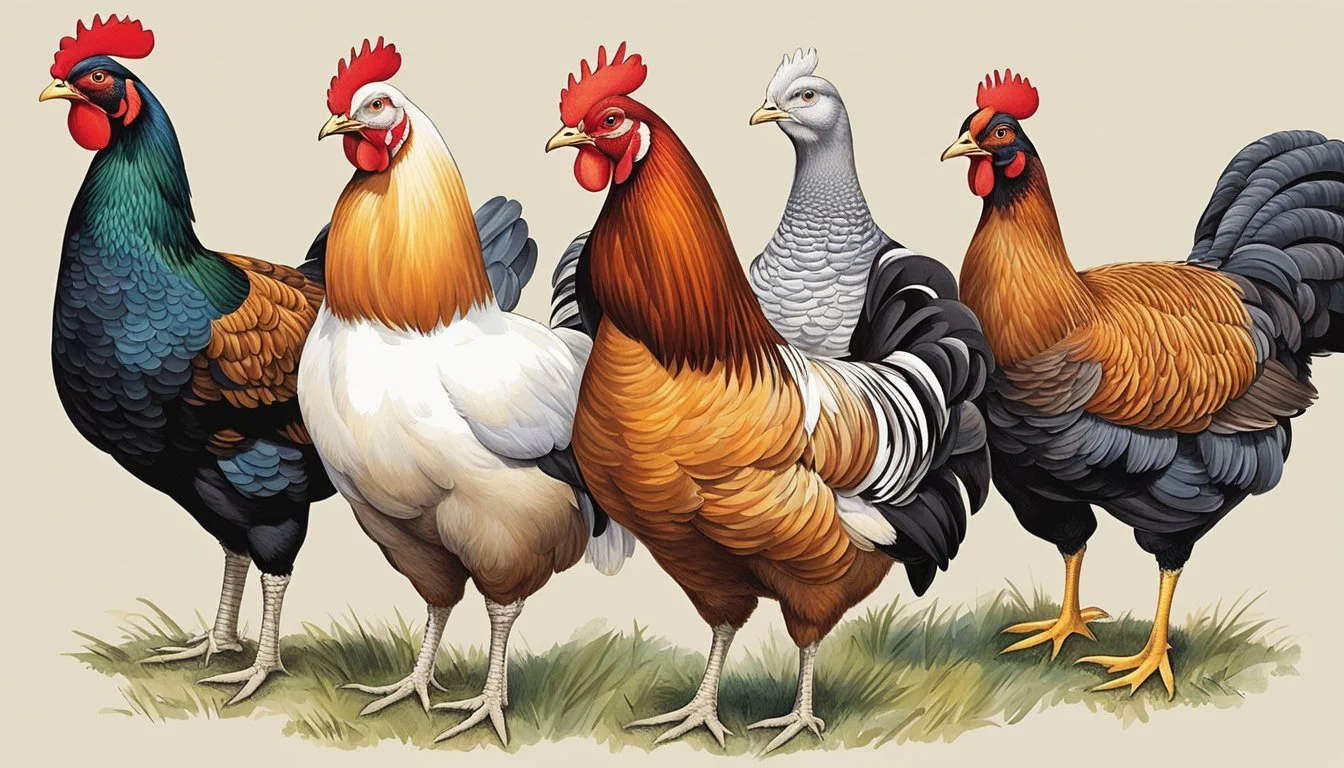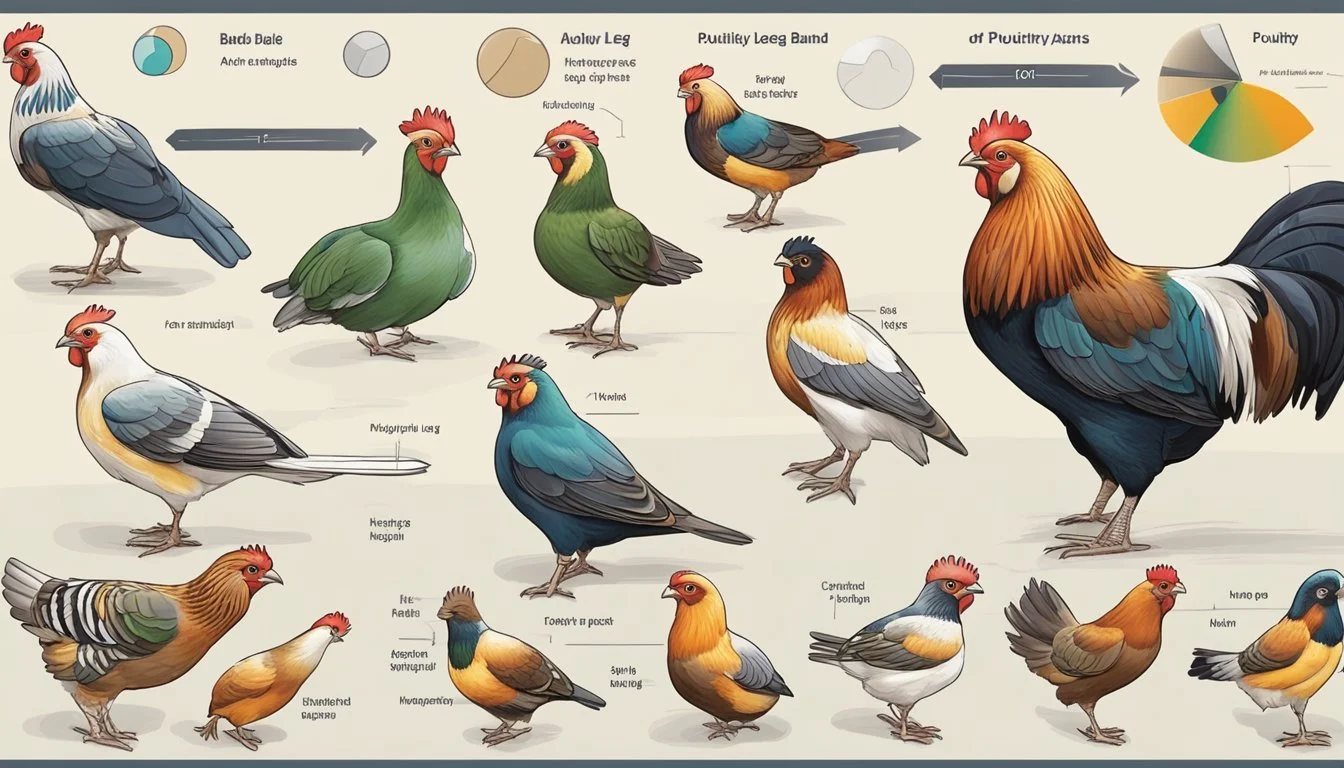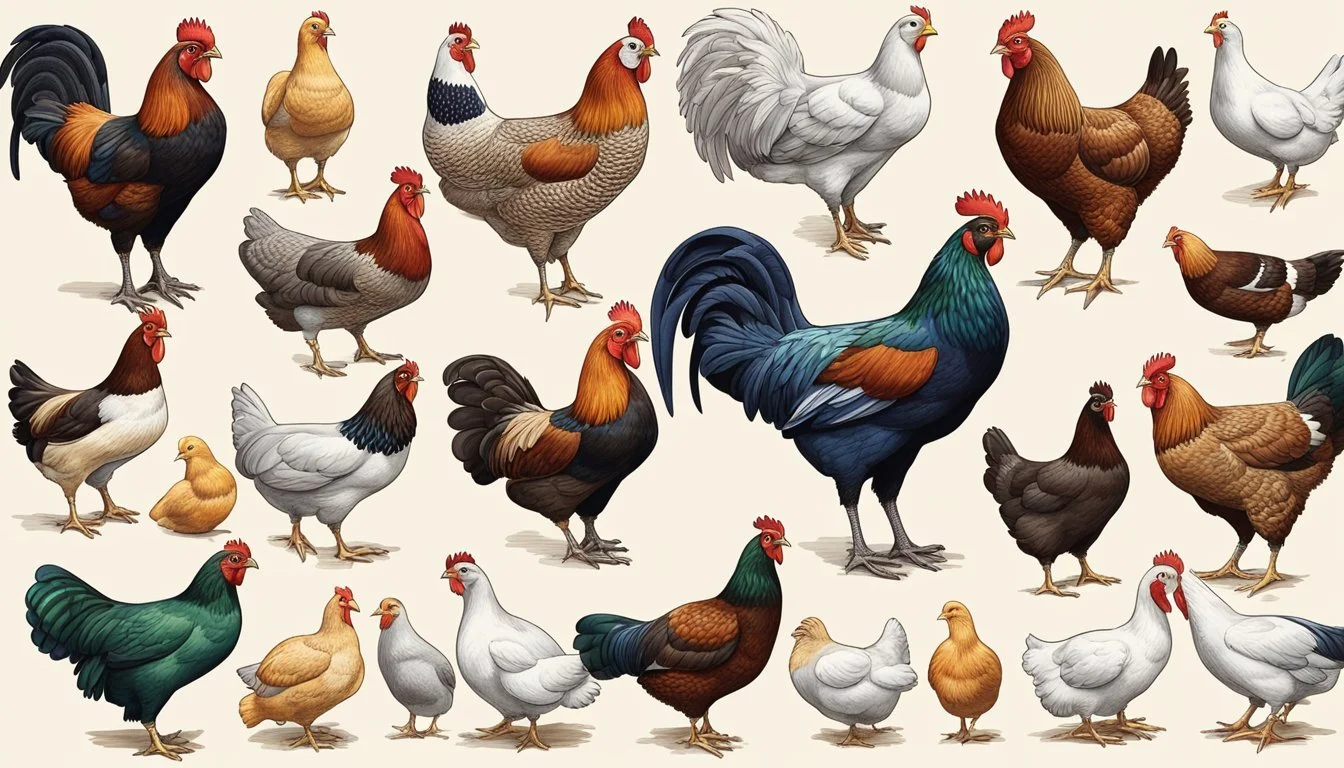The Ultimate Guide to Poultry Leg Bands
Essential Identification Tips for Homestead Birds
Leg bands provide an efficient way for homesteaders to manage and identify their poultry flock. Whether for small-scale backyard keepers or larger poultry operations, these simple devices are invaluable for tracking age, breed, or any special characteristics of individual birds. They are easily attached to a bird's leg, come in a variety of colors and styles, and are designed to be comfortable and safe for long-term use.
The identification system implemented through leg banding allows for quick visual sorting and helps maintain accurate records, which is especially critical for breeding programs, health management, and egg production tracking. While leg bands are the preferred method for many, alternative options such as wing bands or toe punching exist, though these are often more suited to large-scale operations due to their more invasive nature.
Differentiating between birds using leg bands also aids in monitoring the health and growth of poultry, making it a must-have tool for a well-managed homestead. With attention to the proper sizing and secure attachment, leg bands can serve as a simple yet effective method for organizing a successful and responsible poultry keeping endeavor.
Understanding Poultry Leg Bands
Poultry leg bands are essential for managing and identifying birds on a homestead, ensuring accurate tracking of lineage, health, and productivity. They cater to various bird types and come in different sizes, materials, and designs to suit specific needs.
The Importance of Identification
Bird identification is crucial for homestead owners who breed poultry. It allows them to monitor the birds' age, breeding cycles, and health status. For instance, tracking laying hens helps optimize egg production, while identifying meat birds ensures proper marketing and processing. Leg bands, serving as wearable records for each bird, are instrumental in effective flock management.
Types of Leg Bands
Leg bands are categorized primarily into open bands and closed bands. Open bands, often made of plastic or metal, wrap around the bird's leg and can be adjusted or removed as needed. Closed bands, conversely, are continuous rings that are typically placed on young birds, such as chickens at two weeks of age, when their feet are small enough to fit through the band. Special tools, like pliers, are required to affix closed bands. Bandettes is another popular term for leg bands, referring specifically to the colored plastic bands with large numbers for easy visual identification.
Leg Band Sizes and Their Significance
The size of the leg band is critical to ensure the bird's comfort and safety. An ill-fitting band can cause harm or become lost, defeating its purpose. Here's a basic sizing guide:
Bantams: Small bands that don't hinder the leg's growth or restrict movement.
Ducks and Geese: Larger bands tailored to their thicker legs for a snug, but not tight fit.
Turkeys (What wine goes well with turkey?): Even larger bands due to their substantial leg size.
Proper sizing allows for slight movement of the band on the leg without risk of injury, ensuring the band remains secure throughout the bird's life stages. Homesteaders often refer to size charts or measure the bird's leg diameter to select the appropriate band size. Leg rings are a similar concept and often used interchangeably with leg bands.
Remember to routinely check the fit of the bands, especially as young birds grow, to ensure continuous comfort and to adjust or replace bands as needed for the well-being of the poultry.
Selecting the Right Leg Bands
Choosing the appropriate leg bands for poultry is crucial for accurate identification while ensuring the birds' safety and comfort. This involves understanding the different materials available and recognizing the importance of the size and fit of the band.
Material Choices
Plastic and metal are the two primary materials used for poultry leg bands. Plastic leg bands are lightweight and come in a variety of vibrant colors, which makes it easy to identify the birds at a glance. They often feature a simple snap or clip mechanism for closure. Metal leg bands, while heavier, offer durability and are generally considered more permanent. They are typically used as closed bands that need to be applied when the chick is very young.
Plastic:
Lightweight
Colorful
Snap/clip closure
Metal:
Durable
Permanent
Applied on young chicks
Comfort and Safety Considerations
When selecting leg bands, one must ensure they are the correct size for the bird's species, whether it's chickens, ducks, or other poultry. It's important that bands are not too tight, as this can cause discomfort or injury, and not too loose, as they may fall off. A properly fitted band will allow for growth and movement without impeding the bird's natural behavior.
For breeds with feathered legs, a larger leg band size is recommended to allow room for the feathers and prevent restriction. It might be beneficial to utilize a small amount of Vaseline to ease the application process for tighter-fitting bands. Always check for proper fit periodically, especially as birds grow.
Sizes:
Match band size to poultry species and leg diameter.
Allow for growth and natural movement.
Chickens and Ducks:
Chickens: Bands can be applied as early as two weeks old.
Ducks: Sizes may vary; check for a proper fit.
Additional Tips:
For feathered breeds, use a larger band.
A dab of Vaseline may assist with fitting bands.
By considering these factors, one can select leg bands that are both functional for identification and safe for the poultry.
Applying Leg Bands to Poultry
Leg bands are an invaluable tool for breeders aiming to keep track of poultry lineage and health status, especially during quarantine when separating new birds from the flock.
Step-by-Step Application Guide
Preparation: The breeder should gather all necessary materials, including the correct size and type of leg bands, pliers for closing bands, and a record book for documentation.
Capture: Securely hold the bird, possibly with the assistance of another person to prevent injury.
Sizing: Make sure the band fits properly, neither too tight nor too loose. For chickens younger than two weeks, wait until they are old enough for bands to stay on.
Placement: Slide the band over the bird's foot to its leg. For closed bands, use a tool to seal the band without pinching the bird's leg.
Documentation: Record the band number and the bird's details in the record book to ensure proper tracking and identification during subsequent breeding or quarantine periods.
Common Application Mistakes
Incorrect Sizing: Bands that are too tight can cause harm, while too loose bands can fall off. Use a band that allows for growth, particularly for feathered breeds.
Improper Handling: Inadequate restraint of the bird can lead to escape or injury. Ensure the bird is calmly and securely held throughout the process.
Forgetting to Record: Omitting documentation makes the leg banding process fruitless. Record each bird's band number and details immediately after application.
Management and Record Keeping
The use of leg bands on poultry allows homesteaders to effectively manage and record vital information on each bird. This system provides a robust means to track breeding, vaccinations, and other critical data.
Maintaining Identification Records
Homesteaders must routinely maintain identification records to track the history and health of their birds effectively. Each poultry member should have a unique number assigned through leg bands, which corresponds to an individual record. Records should include:
Date of Banding: The date when the leg band was first applied.
Identification Number: The unique number on the leg band.
Breed Information: Details on the poultry's breed.
Age: Time of hatch or approximate age if unknown.
Vaccination Dates: A log of when vaccines were administered.
Breeding Records: Notation of mating pairs and the offspring.
This information can be kept in a digital spreadsheet or a physical ledger. It's crucial for homesteaders to consistently update these records following any changes or events.
Updating Band Information
As poultry grow or when more detailed tracking is necessary, homesteaders may need to update band information. This might include:
Changing to a larger band size to accommodate growth, ensuring no harm comes to the bird.
Re-banding if the original band is lost or damaged.
Adding new bands to denote different vaccines or breeding cycles.
Regularly updating this information ensures that the identification system remains both effective and humane, safeguarding the well-being of the poultry while providing accurate data for the homesteader's use.
Breeding and Hatchery Tracking
In effective poultry management, leg bands are indispensable tools for tracking genetic lineage and the progress of each bird from incubation to adulthood.
Genetic Lineage and Breeder Information
Breeders employ poultry leg bands to maintain accurate records of each chicken’s genetic lineage, which is pivotal for the continuation of desired breed characteristics and overall flock health. The bands, which can vary in color and size, correspond to breeder information and are often inscribed with codes to denote different genetic lines.
Color Coding: Assign a specific color to each chicken breed or genetic line for quick identification.
Numbering System: Use a sequence of numbers or letters to denote individual birds from the same lineage.
Record Keeping: Maintain a detailed log correlating band colors and numbers to breeder information (e.g. sire and dam).
Incubator and Brooding Management
Leg bands play a critical role in the management of eggs and chicks within incubators and brooding setups. They facilitate the tracking of eggs’ collection dates, incubation periods, and the chicks’ growth after hatching.
Egg Collection: Mark eggs with dates and breeding information before placing them in the incubator.
Hatch Tracking: Once chicks hatch, fit them with appropriately-sized leg bands to trace their progress from specific eggs.
Brooding: Monitor growth and health in the brooding area more efficiently, noting any changes in each chick’s file based on their unique band identifier.
Employing these practices enables breeders to optimize mating pairs, maintain genetic diversity, and manage growth records, all of which contribute to the successful reproduction and rearing of poultry on any scale.
Health and Quarantine Measures
Implementing stringent health and quarantine measures is vital for disease control in poultry management. It ensures the safety of the flock from contagious diseases and helps identify any potential health risks promptly.
Disease Control and Prevention
Biosecurity measures are the first line of defense against the transmission of diseases in poultry. Controlling access to the birds and maintaining rigorous sanitation practices prevent the introduction and spread of pathogens. Vaccines play a critical role in disease prevention, and their administration should follow a specific schedule tailored to the needs of the poultry. Different vaccines may be required based on regional disease prevalence and the specific vulnerabilities of the flock.
Regular observation for signs of illness helps in early detection and response. Should any bird show symptoms, it's imperative to isolate it immediately to prevent contagion. Quarantine protocols, which typically recommend a period of at least 30 days for new or ill birds, are essential in monitoring the health status before integration or reintroduction to the flock.
Using Leg Bands in Quarantine Protocols
Leg bands are crucial tools in quarantine management and serve multiple functions:
Identification: Assigning leg bands to new or ill birds allows for easy identification during the quarantine period.
Monitoring: Different sizes and colors of leg bands can be used to mark birds from various sources or with distinct health statuses.
Record-keeping: Tracking vaccinations and treatments becomes more manageable when individual birds are marked with leg bands.
Birds in quarantine should be handled last, after attending to the non-quarantined poultry, to avoid potential cross-contamination. Hands should be washed, and clothes changed post-interaction with quarantined birds. In cases of dealing with sick poultry, a shower is advised to ensure that no pathogens are carried over to healthy birds.
Predator control is another aspect where leg bands can indirectly assist. By being able to quickly identify a bird, owners can more efficiently track if specific birds are being targeted or if certain areas are more prone to predator attacks, thus adjusting their predator control measures accordingly.
Alternative Identification Methods
While leg bands are a popular choice for poultry identification, alternative methods such as tattoos and microchips provide additional options for bird owners seeking a more permanent solution.
Tattoos and Microchips
Tattoos involve inscribing a unique code on an inconspicuous part of the bird, typically on the inside of the wing or the web of the foot. This method is more common in certain countries, like the UK, where regulations and poultry-keeping practices may differ from other regions.
Microchips, on the other hand, offer a high-tech identification solution. A microchip is a small electronic chip encased in a glass cylinder, roughly the size of a grain of rice. It is implanted under the bird's skin, typically near the neck, where it remains for the bird's life. These chips are read with a scanner, which displays the unique identification number linked to the owner's details.
Pros and Cons of Different Methods
Leg Bands:
Pros: Easy to apply and remove; visible; good for quick and non-invasive identification.
Cons: Can get lost or cause injury if improperly fitted; not a permanent solution.
Tattoos:
Pros: Permanent; don't require special equipment to see.
Cons: Can fade over time; application can cause discomfort.
Microchips:
Pros: Permanent; difficult to tamper with; can hold more information than a tattoo or band.
Cons: Requires a special scanner to read; more costly; implantation is invasive and requires a professional.
Each method has its own set of advantages and considerations. The bird's welfare, the ease of identification, and the regulatory requirements of the region (such as in the UK) must all be taken into account when selecting the most appropriate identification method for poultry on a homestead.
Special Considerations for Different Species
When using leg bands for poultry, it's crucial to consider the varied requirements of different species. Size appropriateness, banding timelines, and the physical impact on the bird are all species-specific factors that must be accounted for.
Identifying Chickens Versus Other Birds
Chickens have a range of leg sizes that correspond with their breed. Bantam chickens, for example, require smaller bands than standard breeds. Contrastingly, ducks and geese have thicker legs and thus need larger bands to accommodate their size without causing discomfort. For these waterfowl, durable materials that withstand frequent exposure to water are imperative. Pheasants, on the other hand, are more active and may require more secure banding to prevent loss during their swift movements.
Leg Bands for Rare and Exotic Birds
Birds such as turkeys and exotic fowl require bands that not only reflect their size but also their growth rate. A turkey's leg, significantly larger than that of a chicken, mandates a much larger band. Exotic and rare birds, which might be of various sizes, often necessitate custom-fitted bands. Pigeons, possessing slender legs, are at the opposite end of the spectrum and need smaller, lightweight bands that do not impede their ability to fly or perch.
Identifying the correct size and type of leg band is vital for the well-being of the bird, considering their growth patterns and the environment they thrive in. Proper banding aids in effective flock management and the protection of valuable genetic lines in rare species.
Leg Bands in Farming and Homesteading
Leg bands are invaluable for efficient identification, which is pivotal for anyone raising poultry for eggs, meat, or even as pets. Managing and caring for birds on a homestead requires attention to detail and sustainable practices. Leg bands play a crucial role in these endeavors.
Raising Chickens for Eggs and Meat
When focusing on egg and meat production, leg bands allow homesteaders to track the age and breed of their chickens efficiently. Knowing the type of chickens and their intended purpose (whether for laying eggs or for meat) helps in planning and resource allocation. Dual-purpose breeds, which are good for both meat and foraging for eggs, can be identified quickly with leg bands. For those chicken breeds known for their docile nature, specific colors or patterns in leg bands can help in quick recognition, aiding in the selection process for breeding or sale.
Egg Production: Leg bands are used to identify layers, track laying cycles, and monitor health for optimal production.
Meat Production: They help determine the right time for processing based on the identified age and growth rate of the birds.
The Role of Leg Bands in Sustainable Practices
Sustainable homesteading emphasizes the wellbeing of livestock and the efficient use of resources. Leg bands contribute to these practices by enabling homesteaders to keep accurate records for their flocks. Whether the birds are in enclosures or free-ranging within safely fenced areas, leg bands provide a non-invasive method to monitor the flock's composition, health, and behavior.
Homesteaders can leverage leg bands to track foraging behavior, which can influence decisions on pasture management and supplementary feeding. Using bands can also assist in managing genetic diversity, as identification can help prevent inbreeding and promote the selection of best-performing birds. This level of meticulous record-keeping cultivates a blueprint for responsible farming and caring for your homestead's birds, ensuring a healthy, productive environment for poultry.





